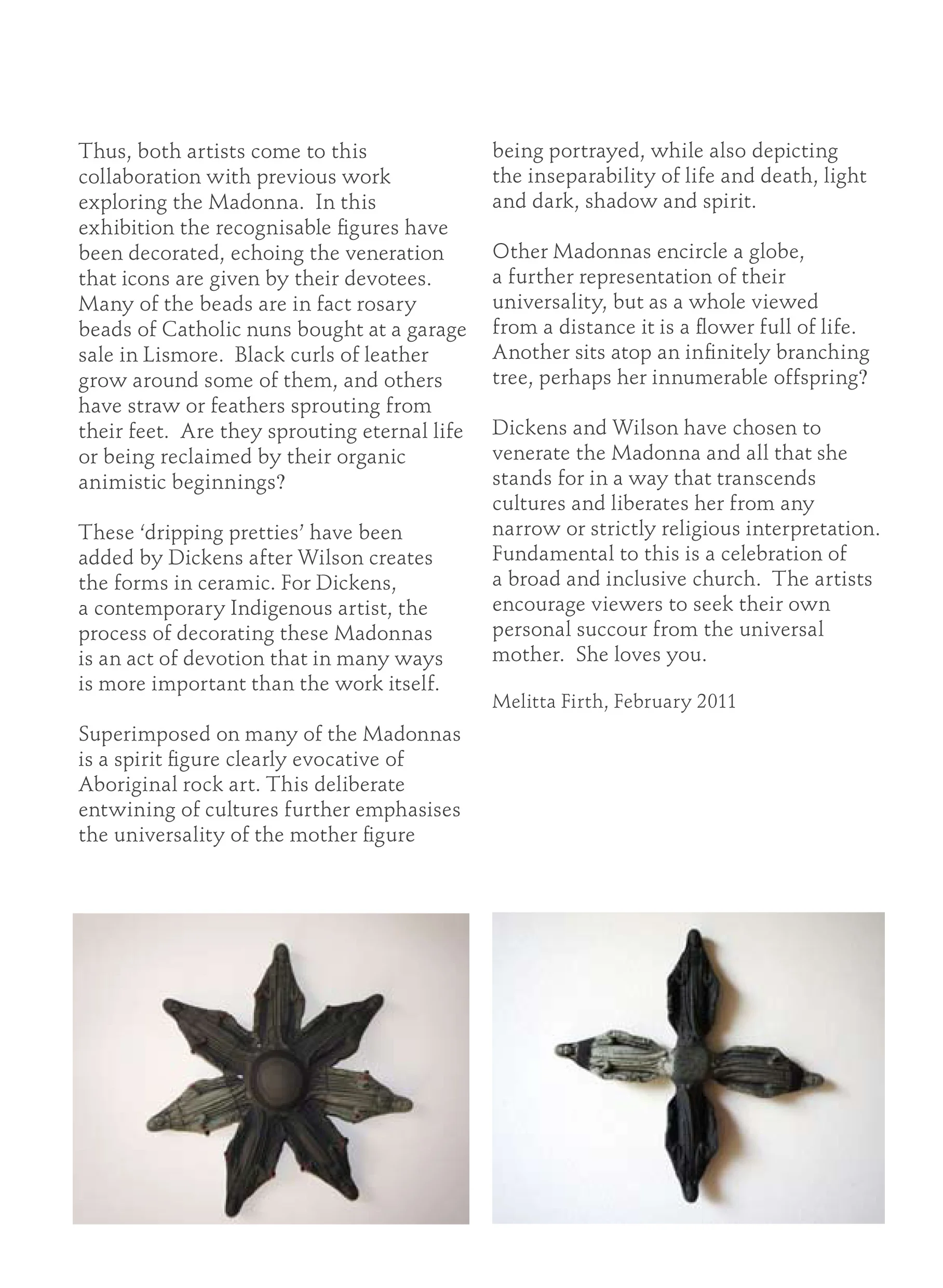(Catalogue Essay)
The widespread and profound symbolism of the Madonna or Virgin Mary, in image, form or even concept, could not be denied by even the most trenchant atheist. She is an unmistakable metaphor for the ultimate mother, infinite love, compassion, and supernatural purity.
To this heady mix of meaning the Black Madonna brings even richer symbolism. Far from being a provocative contemporary appropriation, the black Madonna has a defiantly mysterious origin that predates Christ by centuries and spans many cultures.
Some believe the black Madonna evolved as an ancestor of earlier earth goddesses and pre-christian mothers such as Isis, the dark skinned Egyptian goddess of motherhood, magic and fertility, who is often depicted with her son Horus, the sky god and 'saviour'.
From these misty beginnings hundreds of pictures and statues of black Madonnas, many of them centuries old, are venerated today, still listening to the prayers of countless pilgrims and churchgoers. There is even an annual parade of a black Madonna through the streets of Fremantle, Perth.
The work in Mother of All continues this long tradition of reinterpreting, venerating and seeking solace in an exultant mother figure. In this collaboration, artists Karla Dickens and Ishta Wilson create Madonnas that are clearly not white. But nor are they black. '“They are purposefully grey", says Wilson. By being different greys these Madonnas transcend culture and creed. Liberated from any designation, “they represent the ultimate universal mother for all people in their different shades of grey".
Both artists have been drawn individually to the Madonna in earlier investigations of identity and self, and their mutual interest in spirituality, mysticism, and the metaphysical world.
Dickens is often stirred to create in response to signs, totems and omens to which she is highly attuned. The crows that appeared on her window embodied her ancestors and inspired the works in her Loving Memory series. While her initial Black Madonna series was prompted by a visit from a bad spirit to her house.
After that the Madonna moved in to my life and my work and from this the idea for the Mother of All collaboration developed", says Dickens. Similarly Wilson's fascination with the Virgin began with a conversation with a spirit. Spiritual ideas have always been important to Wilson who grew up with Rajneesh parents. After being deeply affected by a candlelight vigil for a woman murdered in Lismore where she lives and works, Wilson says she had “a chat with the Virgin outside the church". Thus began her body of work Compassion virgins, slip cast porcelain Virgins examining violence against women. “They are an expression of the strength, beauty, divinity, and potentially wrath, within every woman. But by using the Madonna there is the overarching theme of compassion and divinity within everybody", says Wilson.
Thus, both artists come to this collaboration with previous work exploring the Madonna. In this exhibition the recognisable figures have been decorated, echoing the veneration that icons are given by their devotees. Many of the beads are in fact rosary beads of Catholic nuns bought at a garage sale in Lismore. Black curls of leather grow around some of them, and others have straw or feathers sprouting from their feet. Are they sprouting eternal life or being reclaimed by their organic animistic beginnings?
These ‘dripping pretties' have been added by Dickens after Wilson creates the forms in ceramic. For Dickens, a contemporary Indigenous artist, the process of decorating these Madonnas is an act of devotion that in many ways is more important than the work itself.
Superimposed on many of the Madonnas is a spirit figure clearly evocative of Aboriginal rock art. This deliberate entwining of cultures further emphasises the universality of the mother figure
Mother of All: Karla Dickens and Ishta Wilson'Exhibition at Tweed River Art Gallery.


